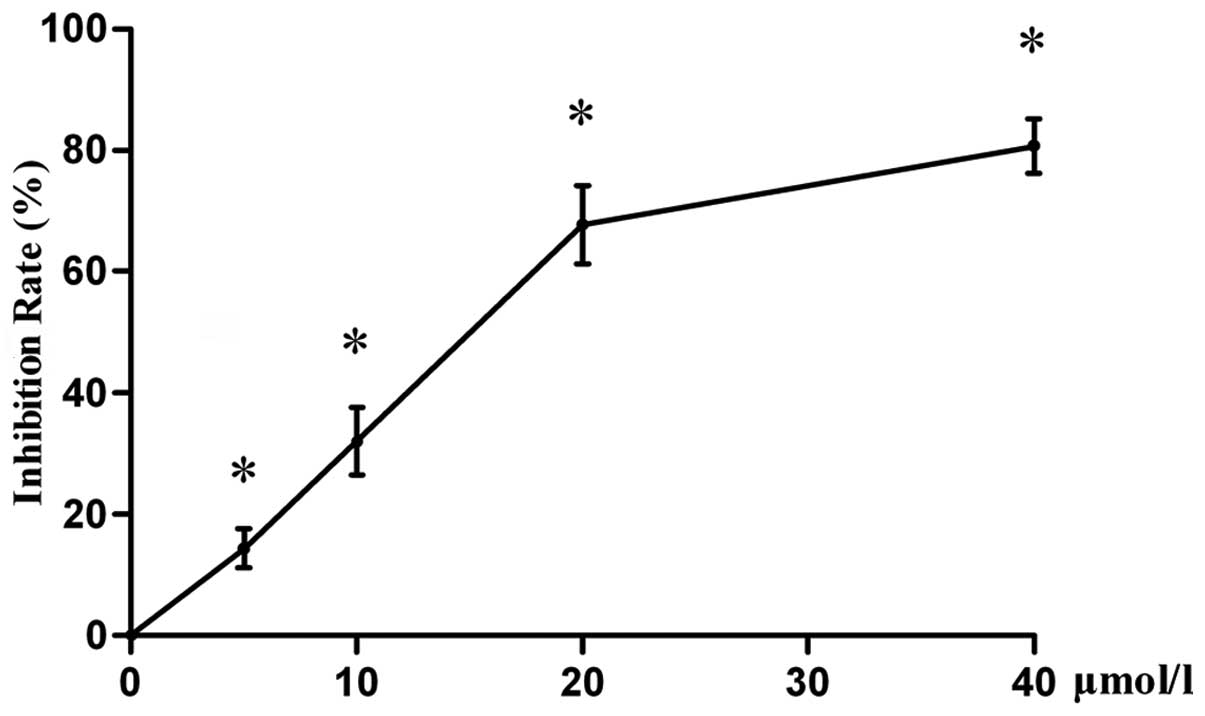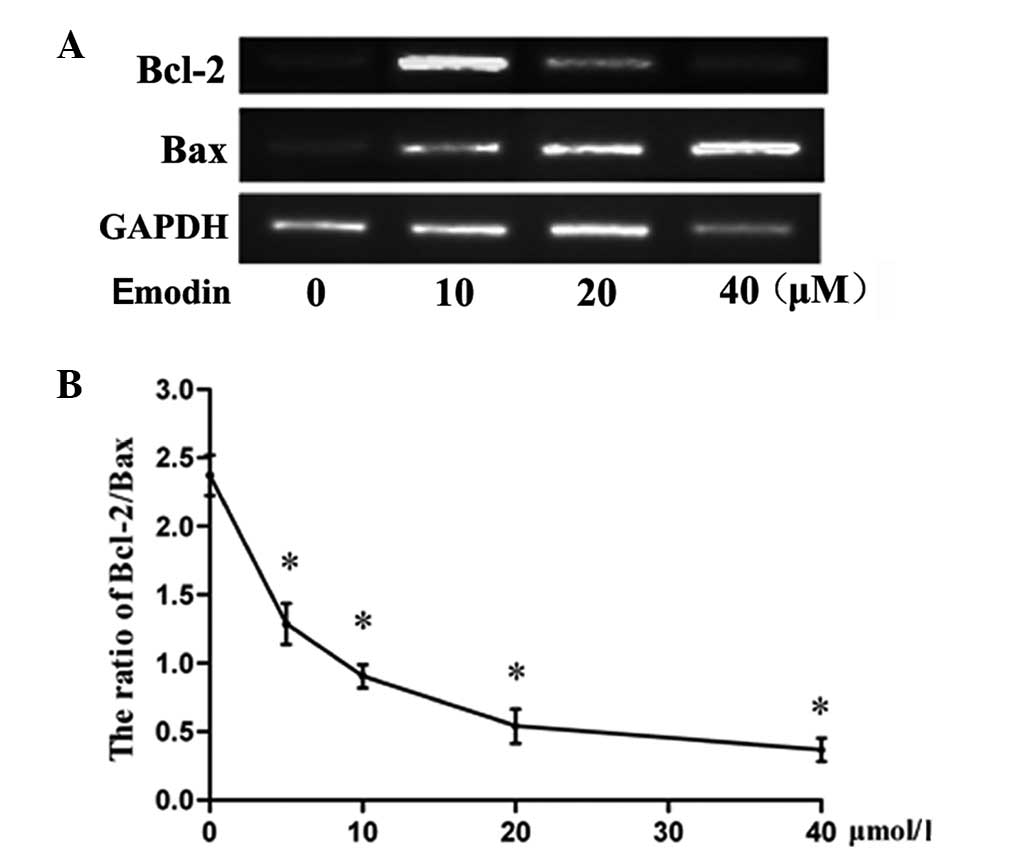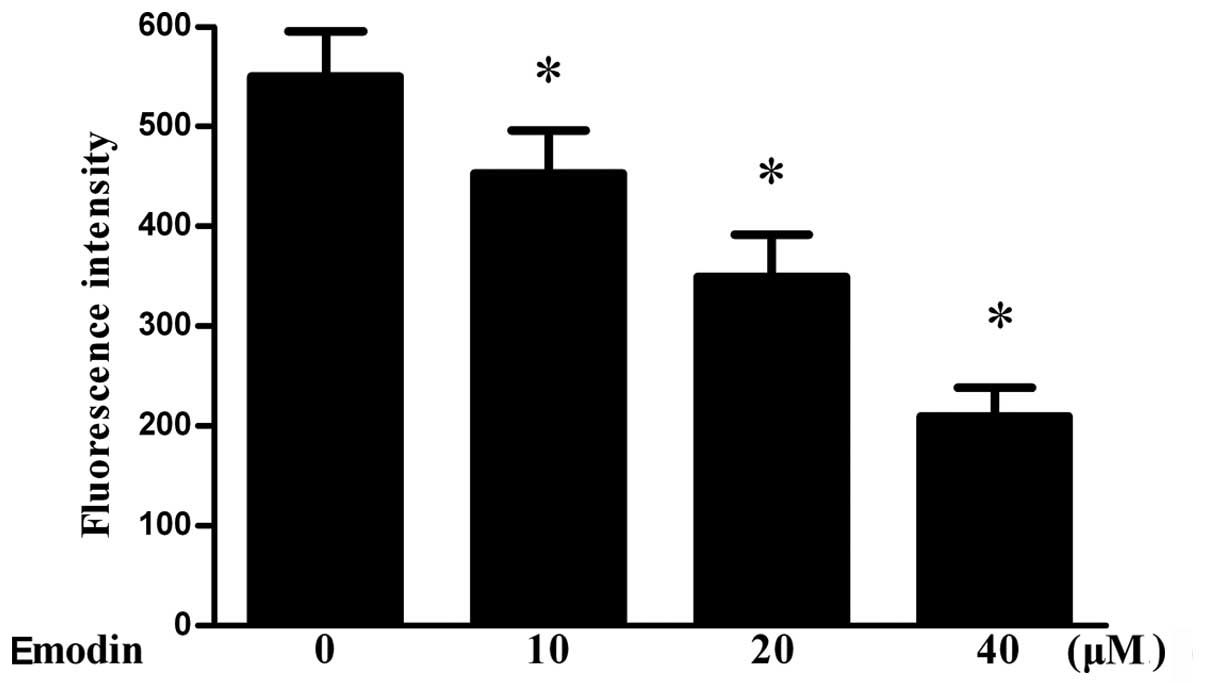Emodin inhibits LOVO colorectal cancer cell proliferation via the regulation of the Bcl-2/Bax ratio and cytochrome c
- Authors:
- Published online on: August 11, 2014 https://doi.org/10.3892/etm.2014.1900
- Pages: 1225-1228
Abstract
Introduction
Colorectal cancer is one of the leading causes of mortality and is a major public health concern worldwide (Guo). The incidence of colorectal cancer is also increasing among the Chinese population (Jin). Chemoprevention is the most promising strategy since other therapies are not effective in controlling gastrointestinal cancers (Andre). However, recent studies have focused on the antitumor properties of natural products since these materials typically have fewer side-effects and are more suitable for long-term use compared with chemically synthesized medicines (16). Emodin, a naturally occurring compound that may be extracted from various Chinese plants, including Rheum officinale and Polygonum cuspidatum (1), is known for its anticarcinogenic effects that have been demonstrated in a variety of experimental cancer models (2). Pharmacological studies have shown that emodin exhibits anticancer effects in a number of human cancers (3). In addition, previous studies have shown that emodin exerts antiproliferative and apoptosis-inducing effects on cell lines derived from ovarian (4) and lung (5) cancer and leukemia (6). However, at present there is little information demonstrating the possible antiproliferative effect of emodin on colorectal cancer. Therefore, in the present study, the inhibitory effect of emodin on cell proliferation in a colorectal cancer cell line was investigated, as well as the molecular mechanisms involved.
Materials and methods
Cell culture and treatment
LOVO colorectal cancer cells were purchased from the American Type Culture Collection (ATCC, Manassas, VA, USA). The cells were cultured as monolayers in RPMI-1640 medium (Gibco-BRL, Gaithersburg, MD, USA) supplemented with 10% fetal bovine serum (Gibco-BRL, São Paulo, Brazil) and 1% penicillin/streptomycin. The cells were grown at 37°C in a humidified atmosphere containing 5% CO2. Emodin was purchased from Sigma-Aldrich (St. Louis, MO, USA) and was freshly diluted to concentrations of 0, 10, 20 and 40 μmol/l with dimethyl sulfoxide (DMSO). The final concentration of DMSO was <0.1%. The cells were treated with different concentrations of emodin for 24 h and then analyzed.
Cell viability assay
Cell viability was determined using Cell-Counting kit-8 (CCK-8, Dojindo Laboratories, Tokyo, Japan). Cells were seeded into a 96-well plate at a density of 5×105 cells/well and cultured for 24 h. Emodin was then added to the wells with final concentrations of 0, 10, 20 and 40 μmol/l; DMSO alone was used for the control group. After 24 h, CCK-8 solution was added (10 μl to each well containing 100 μl medium). The plates were incubated at 37°C for 4 h, and the absorbance at 450 nm was then measured using a Benchmark Plus microplate reader (Bio-Rad, Hercules, CA, USA). All experiments were performed in triplicate.
Reverse transcription polymerase chain reaction (RT-PCR)
Total RNA was isolated from cells using TRIzol® reagent (Invitrogen Life Technologies, Carlsbad, CA, USA) and quantified using UV absorption at 260 and 280 nm. RT-PCR was performed in accordance with the reverse-transcription PCR (RT-PCR) reaction kit (GIBCO, Grand Island, NY, USA) instructions. RT-PCR primers were designed as follows: B-cell lymphoma-2 (Bcl-2) forward, 5′-CTTTTGCTGTGGGGT TTTGT-3′ and reverse, 5′-GTCATTCTGGCCTCTCTTGC-3′; Bcl-2-associated X protein (Bax) forward, 5′-GGAGCT GCAGAGGATGATTG-3′ and reverse, 5′-CCTCCCAGA AAAATGCCATA-3′. The RT-PCR process was performed as follows: Denaturation for 1 min at 93°C, followed by 31, 33 and 32 cycles of denaturing for 30 sec at 94°C, annealing for 1 min at 57°C, 60°C and 57°C for GAPDH, Bcl-2 and Bax, respectively, and extension for 2 min at 72°C. The amplified products were visualized using 1.5% agarose gel electrophoresis, stained with ethidium bromide and images were then captured under ultraviolet light. Densitometric analysis of three different observations was performed using Quantity One Software (Bio-Rad). The quantity of each transcript was normalized against GAPDH.
Western blot analysis
The cells were harvested at the indicated times, and lysed with lysis buffer [50 mM Tris Cl, (pH 7.8), 150 mM NaCl, 1% NP40, 0.1% SDS, 1 mM phenylmethylsulfonyl fluoride]. The total protein (50 μg per well) was separated by 10% SDS-PAGE gels, and electrophoretically transferred onto nitrocellulose membranes. Following blocking for 1 h with 5% skimmed milk in Tris-buffered saline (TBS) buffer (10 mM Tris and 150 mM NaCl), the membrane was washed 3 times for 18 min each with TBST buffer (10 mM Tris, 150 mM NaCl and 0.1% Tween-20). Immunoreactive bands were visualized using horseradish peroxidase-conjugated secondary antibody (1:5,000 dilution; Beyotime Institute of Biotechnology, Haimen, Jiangsu, China) and an enhanced chemiluminescene western blotting detection kit (Amersham, Little Chalfont, Buckinghamshire, UK). The bands were visualized using the enhanced chemilluminescence system, and the band density was determined by Image J software (National Institutes of Health, Bethestha, MD, USA. The antibodies were all purchased from Beyotime Institute of Biotechnology.
Mitochondrial membrane potential assay
Mitochondrial potential was analyzed using the fluorescent potentiometric dye JC-1 as described previously (7). Briefly, following 24 h of treatment with 0–40 μmol/l emodin, cells were harvested, washed twice with phosphate-buffered saline (PBS) and centrifuged for 8 min at 450 × g at room temperature. The cells were then suspended with JC-1 (5 μg/ml) in serum-free RPMI-1640 and incubated for 15 min at 37°C. Following staining, the cells were collected at room temperature and washed three times with pre-warmed PBS. The cell pellet was then re-suspended in 1 ml PBS. Fluorescence emitted by JC-1 was quantified using a fluorescence plate reader (Molecular Devices, Sunnyvale, CA, USA) at 37°C. The fluorescence of the JC-1 monomer was measured at 485 nm excitation wavelength/530 nm emission wavelength. The fluorescence of the JC-1 aggregate was measured at 535 nm excitation wavelength/590 nm emission wavelength. For each experiment, the ratios of JC-1 aggregate to JC-1 monomer were normalized against untreated controls; the values therefore represent a percentage of the mitochondrial function in untreated cells.
Analysis of cytochrome c release
Cytochrome c release from the mitochondria was evaluated by western blot analysis of cytosolic protein samples (8,9). Cells were harvested following treatment with emodin for 24 h and mixed with 100 μl cold lysis buffer [50 mmol/l Tris-HCl (pH 7.4), 1 mmol/l NaF, 150 mmol/l NaCl, 1 mmol/l ethylene glycol tetraacetic acid, 1 mmol/l phenylmethylsulfonyl fluoride (PMSF), 1% (v/v) Nonidet P-40 (NP-40) and 10 μg/ml leupeptin], followed by centrifugation at 10,000 × g for 30 min at 4°C. The supernatant was centrifuged two more times under the same conditions to remove the nuclear debris. The cytosolic extracts were then used for western blot analysis to analyze the level of cytochrome c release. Western blot analysis was subsequently performed as described above.
Statistical analysis
Data are expressed as the means ± standard deviation of three assays. The statistical analysis was performed using a one-way analysis of variance. A P-value of <0.05 was considered to indicate a statistically significant difference. All statistical analyses were performed using SPSS 13.0 software (SPSS, Inc., Chicago, IL, USA).
Results
Effect of emodin on cell viability
In order to investigate the antiproliferative effect of emodin on LOVO cells in vitro, cell proliferation was measured using the CCK-8 assay. The results of the present study (Fig. 1) demonstrated that emodin inhibits cell proliferation in a concentration-dependent manner, compared with that of vehicle-treated controls (P<0.05).
Effect of emodin on Bcl-2 and Bax expression in LOVO cells
RT-PCR was performed to determined the Bcl-2 and Bax expression levels of the cells. It was found that emodin upregulated the expression of Bax in the treatment groups compared with that in the control group (P<0.05), whereas it inhibited the expression of Bcl-2 (Fig. 2). Furthermore, significant differences in the Bax/Bcl-2 ratio between the treatment groups and the control cells were observed (Fig. 2).
Effect of emodin on mitochondrial membrane potential and release of cytochrome c
In order to determine if treatment with emodin decreases the mitochondrial membrane potential, cells were treated with different concentrations of emodin for 24 h prior to measurement of the mitochondrial membrane potential. The results indicated that the mitochondrial membrane potential was significantly decreased by emodin (Fig. 3). In addition, it was found that the release of cytochrome c was significantly increased in cells incubated with 10–40 μmol/l emodin (Fig. 4).
Discussion
Emodin (1,3,8-trihydroxy-6-methylanthraquinone) is a naturally occurring anthraquinone present in rhubarb and numerous other plants. As well as being used as a laxative, emodin has a number of other biological effects, including antibacterial, antiviral, anti-inflammatory and anticancer effects (10). However, at present, there is little evidence of the possible effects of emodin on proliferation in colorectal cancer. Therefore, in the present study, the molecular mechanism involved in the inhibitory effect of emodin on cell proliferation was investigated.
The inhibitory effect of emodin on LOVO colorectal cell proliferation was investigated, as well as the possible underlying mechanisms. It was observed that emodin inhibited LOVO cell proliferation, which is in accordance with a previous study (11).
Bcl-2 family proteins function through different pathways in the regulation of cell apoptosis (12). The Bcl-2 family primarily affects the mitochondrial pathways (13). Bcl-2 and its homologs prevent mitochondrial membrane disruption and the release of cytochrome c and other pro-apoptotic factors, while Bax promotes these events. The expression of these two opposing proteins may, in part, determine the fate of cells. The ratio of Bcl-2/Bax is usually regarded as a criterion for programmed cell death (14). The results from the present study demonstrate that emodin upregulates the expression of Bax, but inhibits the expression of Bcl-2. It was also found that there were significant differences in the Bax/Bcl-2 ratio between the treatment and the control groups. These data are consistent with emodin-inhibited cancer cell growth being associated with the balance of Bcl-2/Bax.
In addition, the mitochondrial pathway is a major apoptosis signaling pathway. Numerous studies have shown that the mitochondrial membrane potential stimulates the mitochondrial membrane to open, resulting in the release of cytochrome c into the cytoplasm, activation of the caspase pathway and degradation of important intracellular proteins, and consequently the induction of apoptosis (15). In the present study, it was found that the mitochondrial membrane potential was significantly decreased by emodin in a concentration- and time-dependent manner. In addition, the results from the western blot analysis revealed that cytochrome c was released from the mitochondria into the cytoplasm, suggesting that the mitochondrial apoptosis pathway is involved in emodin-induced cell line apoptosis. These results are in accordance with a previous study by Wang et al (16), which demonstrated that emodin inhibited HeLa proliferation by the induction of apoptosis through the intrinsic mitochondrial pathway.
In conclusion, the results from the present study suggest that emodin inhibits cancer cell growth via the regulation of Bcl-2/Bax and that the mitochondrial apoptosis pathway may be involved.
References
|
Ma YS, Weng SW, Lin MW, et al: Antitumor effects of emodin on LS1034 human colon cancer cells in vitro and in vivo: roles of apoptotic cell death and LS1034 tumor xenografts model. Food Chem Toxicol. 50:1271–1278. 2012. View Article : Google Scholar : PubMed/NCBI | |
|
Jing X, Ueki N, Cheng J, Imanishi H and Hada T: Induction of apoptosis in hepatocellular carcinoma cell lines by emodin. Jpn J Cancer Res. 93:874–882. 2002. View Article : Google Scholar : PubMed/NCBI | |
|
Liu A, Chen H, Wei W, et al: Antiproliferative and antimetastatic effects of emodin on human pancreatic cancer. Oncol Rep. 26:81–89. 2011.PubMed/NCBI | |
|
Li J, Liu P, Mao H, Wanga A and Zhang X: Emodin sensitizes paclitaxel-resistant human ovarian cancer cells to paclitaxel-induced apoptosis in vitro. Oncol Rep. 21:1605–1610. 2009.PubMed/NCBI | |
|
Ko JC, Su YJ, Lin ST, et al: Suppression of ERCC1 and Rad51 expression through ERK1/2 inactivation is essential in emodin-mediated cytotoxicity in human non-small cell lung cancer cells. Biochem Pharmacol. 79:655–664. 2010. View Article : Google Scholar : PubMed/NCBI | |
|
Wang CG, Yang JQ, Liu BZ, et al: Anti-tumor activity of emodin against human chronic myelocytic leukemia K562 cell lines in vitro and in vivo. Eur J Pharmacol. 627:33–41. 2010. View Article : Google Scholar : PubMed/NCBI | |
|
Shang T, Joseph J, Hillard CJ and Kalyanaraman B: Death-associated protein kinase as a sensor of mitochondrial membrane potential: role of lysosome in mitochondrial toxin-induced cell death. J Biol Chem. 280:34644–34653. 2005. View Article : Google Scholar : PubMed/NCBI | |
|
Bae JH, Park JW and Kwon TK: Ruthenium red, inhibitor of mitochondrial Ca2+ uniporter, inhibits curcumin-induced apoptosis via the prevention of intracellular Ca2+ depletion and cytochrome c release. Biochem Biophys Res Commun. 303:1073–1079. 2003.PubMed/NCBI | |
|
Grishko V, Rachek L, Musiyenko S, Ledoux SP and Wilson GL: Involvement of mtDNA damage in free fatty acid-induced apoptosis. Free Radic Biol Med. 38:755–762. 2005. View Article : Google Scholar : PubMed/NCBI | |
|
Xu JD, Liu S, Wang W, et al: Emodin induces chloride secretion in rat distal colon through activation of mast cells and enteric neurons. Br J Pharmacol. 165:197–207. 2012. View Article : Google Scholar : PubMed/NCBI | |
|
Chen H, Wei W, Guo Y, et al: Enhanced effect of gemcitabine by emodin against pancreatic cancer in vivo via cytochrome C-regulated apoptosis. Oncol Rep. 25:1253–1261. 2011.PubMed/NCBI | |
|
Reed JC: Bcl-2 family proteins. Oncogene. 17:3225–3236. 1998. View Article : Google Scholar | |
|
Wang JB, Qi LL, Zheng SD and Wu TX: Curcumin induces apoptosis through the mitochondria-mediated apoptotic pathway in HT-29 cells. J Zhejiang Univ Sci B. 10:93–102. 2009. View Article : Google Scholar : PubMed/NCBI | |
|
Pettersson F, Dalgleish AG, Bissonnette RP and Colston KW: Retinoids cause apoptosis in pancreatic cancer cells via activation of RAR-gamma and altered expression of Bcl-2/Bax. Br J Cancer. 87:555–561. 2002. View Article : Google Scholar : PubMed/NCBI | |
|
Wang X: The expanding role of mitochondria in apoptosis. Genes Dev. 15:2922–2933. 2001.PubMed/NCBI | |
|
Wang YX, Yu H, Zhang YY, et al: Emodin induces apoptosis of human cervical cancer HeLa cells via intrinsic mitochondrial and extrinsic death receptor pathway. Cancer Cell Int. 13:712013. View Article : Google Scholar : PubMed/NCBI | |
|
Guo LD, Chen XJ, Hu YH, Yu ZJ, Wang D and Liu JZ: Curcumin inhibits proliferation and induces apoptosis of human colorectal cancer cells by activating the mitochondria apoptotic pathway. Phytother Res. 27:422–430. 2013. View Article : Google Scholar : PubMed/NCBI | |
|
Jin P, Wu ZT, Li SR, Li SJ, Wang JH, Wang ZH, Lu JG, Cui XJ, Han Y, Rao J and Sheng JQ: Colorectal cancer screening with fecal occult blood test: A 22-year cohort study. Oncol Lett. 6:576–582. 2013.PubMed/NCBI | |
|
Andre T, Boni C and Mounedji-Boudiaf L: Oxaliplatin, fluorouracil, and leucovorin as adjuvant treatment for colon cancer. N Engl J Med. 350:2343–2351. 2004. View Article : Google Scholar |













